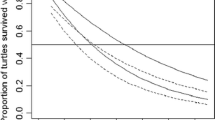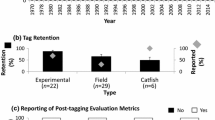Abstract
The high detection rates of acoustic- and radio-tagged fish greatly improve the ability of an investigator to obtain information on survival and movement of fish with fewer tags. The trade-off, though, is a greater dependence on the individual tag performance, as each tagged fish in a smaller study represents a greater proportion of the outcome. This reduction in release size, due to the increase in detection capability, places a greater emphasis on the need to accurately gauge the status of the tagged fish. Should a tag fail while a smolt is migrating through the study area, the release-recapture model cannot discern the difference between smolt death and tag failure. If the release-recapture models are not adjusted for the probability of tag failure, the estimates of smolt survival will therefore be negatively biased. This article presents a semiparametric approach for adjusting survival estimates from release-recapture studies for tag failure, and provides subsequent estimation of sampling variance and its contributing components.
Similar content being viewed by others
References
Aalen, O. O. (1978), “Nonparametric Inference for a Family of Counting Processes,” The Annals of Statistics, 6, 701–726.
Arnason, A. N., and Mills, K. H. (1981), “Bias and Loss of Precision Due to Tag Loss in Jolly-Seber Estimates for Mark-Recapture Experiments,” Canadian Journal of Fisheries and Aquatic Sciences, 38, 1077–1095.
Burnham, K. P., Anderson, D. R., White, G. C., Brownie, C., and Pollock, K. H. (1987), “Design and Analysis Methods for Fish Survival Experiments Based on Release-Recapture,” American Fisheries Society Monograph, 5.
Cowen, L. L., and Schwartz, C. J. (2005), “Capture-Recapture Studies using Radio Telemetry with Premature Radio-tag Failure,” Biometrics, 61, 657–664.
Efron, B., and Tibshirani, R. (1993), An Introduction to the Bootstrap, New York: Chapman & Hall/CRC.
Elandt-Johnson, R. C., and Johnson, N. L. (1980), Survival Models and Data Analysis, New York: Wiley.
English, K. K., Skalski, J. R., Lady, J., Robichaud, D., Nass, B. L., Sliwinski, C., and Blakely, A. (2001), “Survival of Hatchery Chinook Smolts Assessed at Wanapum and Priest Rapids Projects Using Radiotelemetry Techniques, 2001,” Public Utility District No. 2 of Grant County, Ephrata, WA.
Gompertz, B. (1825), “On the Nature of the Function Expressive of the Law of Human Mortality and on the New Mode of Determining the Value of Life Contingencies,” in Philosophical Transactions of the Royal Society of London, 115, 513–585.
Kaplan, E. L., and Meier, P. (1958), “Nonparametric Estimation From Incomplete Observations,” Journal of the American Statistical Association, 53, 457–481.
Manly, B. F. J., and Parr, M. J. (1968), “A New Method of Estimating Population Size, Survivorship and Birth Rate From Capture-Recapture Data,” in Transactions of the Society for British Entomology, 18, 81–89.
Nelson, W. (1972), “Theory and Applications of Hazard Plotting for Censored Failure Data,” Technometrics, 14, 945–965.
Seber, G. A. F. (1982), The Estimation of Animal Abundance, New York: MacMillan.
Skalski, J. R., Smith, S. G., Iwamoto, R. N., Williams, J. G., and Hoffmann, A. (1998), “Use of PIT-tags to Estimate Survival of Migrating Juvenile Salmonids in the Snake and Columbia Rivers,” Canadian Journal of Fisheries and Aquatic Sciences, 55, 1484–1493.
Skalski, J. R., Stevenson, J. R., Lady, J., Townsend, R., Giorgi, A. E., Miller, M., and English, K. (2001), “An Assessment of Project, Pool, and Dam Survival for Chinook and Steelhead Smolts at Rocky Reach and Rock Island Dams Using Radiotelemetry and PIT-tag Techniques, 2000,” Public Utility District No. 1 of Chelan County, Wenatchee, WA.
Skalski, J. R., Townsend, R. L., Steig, T. W., Horchik, J. W., Tritt, G. W., McDonald, R. D., and Grassell, A. (2003), “Estimation of Survival of Yearling Chinook Salmon Smolts at the Rock Island Dam, Pool, and Project in 2002 using Acoustic and PIT-tag Release-Recapture Methods,” Public Utility No. 1 of Chelan County, Wenatchee, WA.
Stevenson, J. R., Skalski, J. R., Lady, J., Townsend, R., Giorgi, A. E., and McDonald, R. (2000), “A Pilot Study Assessing the Feasibility of Using Radiotelemetry and PIT-tag Techniques to Estimate Project, Pool, and Dam Survival of Steelhead Smolts at Rocky Reach and Rock Island Dams, 1999,” Public Utility District No. 1 of Chelan County, Wenatchee, WA.
Author information
Authors and Affiliations
Corresponding author
Rights and permissions
About this article
Cite this article
Townsend, R.L., Skalski, J.R., Dillingham, P. et al. Correcting bias in survival estimation resulting from tag failure in acoustic and radiotelemetry studies. JABES 11, 183 (2006). https://doi.org/10.1198/108571106X111323
Received:
Revised:
DOI: https://doi.org/10.1198/108571106X111323




